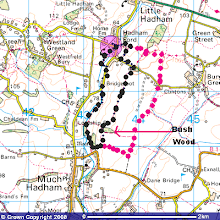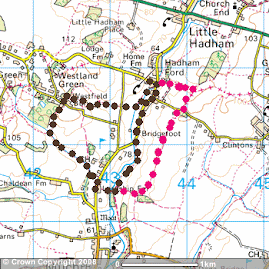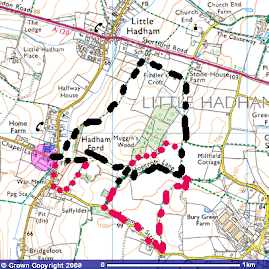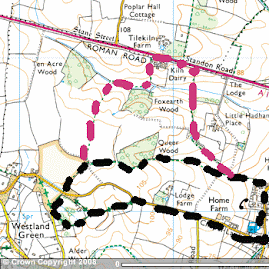Last Wednesday (18th) I picked up Rick in Bishop's Stortford at 5am for a day birding along the North Norfolk coast. Whilst the weather forecast was superb for being out and about (a predicted high of 22C and clear sky) this weather is not conducive for bringing in rarer migrants off the North Sea. Not to worry, a super day was instore.
After a coffee in Wells Next the Sea, where we had both pink footed and brent geese over, we headed East to Kelling Water Meadows and wandered down the green lane to check the flooded area, reeds and hedgerows. Plenty of birds were apparent immediately with huge numbers of goldfinches feeding upon teasels and thistle heads. A good number were juvenile, indicating a successful 3rd brood had recently fledged. We listed over 30 species at this peaceful and rarely visited site, including stonechat, greenshank, shoveler, snipe and a whimbrel. All good birds to get on a day list early on. A pair of Egyptian geese posed for a photo. However, apart from black headed gulls and goldfinches, the most common bird was several coveys of red legged partridge in adjacent fields. In amongst these, a few Grey partridge, too. We fired off photos of several species before returning to the car.
 |
| Juvenile goldfinch |
 |
| adult goldie on the left removing teasel seeds for the juvenile on the right |
 |
| Juvenile with stunning wing plumage |
 |
| Yet another juvenile goldfinch |
 |
| Full adult sporting the familiar head pattern |
 |
| Egyptian goose |
 |
| Overhead shoveler |
 |
| Shoveler, displaying bill shape that gives this bird its name |
 |
| Dunnock |
We headed west with the next stop being Salthouse beach Road for a quick wander to Gramborough Hill for migrants. Here we encountered a typical serious Norfolk birder moaning about the lack of birds. He told us there were just wrens, which we didn't see! However, we managed to get: Little egret, dunlin, skylark, curlew and meadow pipit on to the list along with gulls. Well worth dropping off for a half hour session. The suspected wheatears that are regulars here in autumn failed to show. We headed off to Cley East Bank a few miles further west.
 |
| Adult Meadow pipit. Note long hind claw that is a diagnostic feature . |
Once parked, we wandered along the world famous bird track that is Cley East Bank. A party of 4 Bearded reedlings pinged overhead and were gone before our cameras could capture them. We arrived at the Richie Richardson Hide, named after a great chap who could always be found here. Sadly, he passed away far too early in 1977. An excellent self taught ornithological artist, I had the pleasure of chatting with him on several occasions in the '70's. From this hide we scored with several species: shelduck, grey plover (in excellent breeding plumage,) knot, redshank and Cetti's warbler. A kingfisher darted along a channel as we headed back where more bearded reedlings were seen, albeit briefly.
We popped into the Visitors' Centre for a much needed coffee before stopping off at Cley beach, having driven slowly along Beach Road, checking fields for wheatear. Still not apparent. A chat with a sea watcher and time spent searching the North Sea for passing birds proved fruitful. A summer plumaged Red throated diver, a party of Common scoter, 2 Great skua, juvenile kittiwake, Mediterranean gull and sandwich tern all made the day list. We went off to check the fence posts for wheatear. Third time lucky, one popped up not too far away, but now the sun was bright and the temperature rising so heat haze for photos was becoming an issue. A marsh harrier rose over the reeds in the distance. A wonderful place to be on a calm, sunny and warm Wednesday morning.
 |
| The ever present Meet and Greet Black Headed gull, Cley Beach car park |
 |
| Wheatear on migration route south |
 |
| Same bird. The white eye stripe stopping before the bill indicates a first year bird. |
We continued West with the next stop being for Stiffkey Fen. Another good spot not often visited by the majority of birders. Always worth a check. Little egrets and redshanks in the salt creeks and in the distance at Blakeney Point, a binocular check revealed big numbers of grey and common seal hauled up. We turned our attention to the fen. A remarkable count of 36 spoonbill, a few wigeon, two more flyby kingfishers were of note along with many waders, mute swans, greylag geese. A chiffchaff called from willow before we yet again, made our way back to the car.
 |
| Very distant and heavily cropped shot of some of the spoonbill. Lapwings in the foreground |
 |
| Little egret |
A brief look on Holkham Freshmarsh from Lady Anne's Drive gave little so our next stop was Burnham Overy Staithe where we parked close to the creek as the tide was out. Here, great black backed gull, black tailed godwit, turnstone is different stages of moult as well as regulars such as common, herring and black headed gulls.
 |
| Black tailed godwit |
 |
| Typical feeding posture for Bl T G |
 |
| Diagnostic white wing bar on black tailed godwit, not apparent on similar bar tailed godwit |
 |
| Redshank |
 |
| adult turnstone moulting from breeding plumage |
 |
| Turnstones: centre bird still with remnants of the ruddy breeding plumage. |
On we went with the next stop just off the coast at Choseley Drying barns where I had promised Rick he would get decent close up shots of red legged partridge from the car. Fortunately, the birds performed in the grass verge for some wonderful portraits. We checked the roof of the barn but just 7-8 pied wagtails. Chaffinches on the wires and 8 Common buzzards circling upon thermals overhead. A rook made the day list. Linnets and more goldfinches made the detour worthwhile.
 |
| Overhead, soaring Common buzzard |
 |
| Same bird, suspect 2nd year as no black terminal edging on the tail feathers but the beginning of black edging to the trailing edge of the wings. |
We drove back down to the coast road to our final destination; Titchwell RSPB Reserve. Plenty had been recorded early in the morning from the beach, but unlikely these birds would still be present. I invariably leave Titchwell to last as the light over the Freshmarsh is best for the last few hours of the day, the sun behind you as you scan the marsh. We entered the island hide from where many 100's of birds were noted. I checked the black headed gulls (400+) for anything else: there wasn't whilst Rick photographed a Bearded reedling in nearby Australis phragmites reeds. Ruff, dunlin, Little ringed plover, teal, pied wags, avocet, little grebe, coot, tufted duck, ringed plover, golden plover (200+) a little stint and a garden warbler singing in the willows all were noted before a walk to sea watch and check the beach waders. Out to sea, 2 great crested grebe, oystercatchers at the low tide rock pools, sanderling running along the surf and a whole load of other waders: grey plover, black tailed godwits, curlew, knot etc. We returned along the beach path, a reed bunting overhead before a final stop in the Parrinder Hide for a few photos of dunlin, pied wag etc.
We eventually tore ourselves away, checked the picnic area for a yellow browed warbler with no success. It was probably too late in the day, just a chiffchaff called before getting back to the car and packing away the optics.
 |
| Skulking juvenile male Bearded reedling |
 |
| Juvenile ruff on migration |
 |
| Pied wagtail |
 |
| Little ringed plover |
 |
| Little stint, just showing the "tramlines." These are the parallel white stripes down the back, indicating a first year bird. |
 |
| Shelduck |
 |
| One of many redshank |
 |
| Grey heron |
 |
| Moulting adult dunlin |
 |
| Avocet |
 |
| Linnet |
 |
| Pied wagtail in late afternoon soft light |
 |
| From the footpath looking over the Freshmarsh |
A really superb day with Rick. He had donated a very generous amount to my MindGarden fundraising effort, a Learning Centre in Sri Lanka I have helped establish. It was a pleasure to show him some new habitats a little off the usual beaten tracks for birders to North Norfolk.
 |
| Little ringed plover |
 |
| Bearded reedling |
































































































